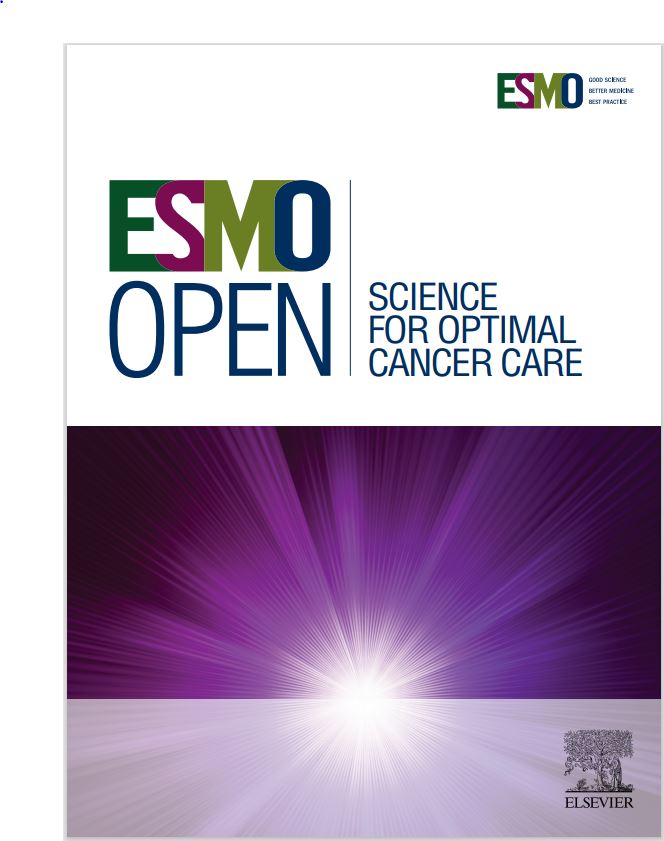基于深度学习的肿瘤浸润淋巴细胞定量作为鼻咽癌预后指标:多队列研究结果
IF 7.1
2区 医学
Q1 ONCOLOGY
引用次数: 0
摘要
鼻咽癌(NPC)具有肿瘤免疫微环境,富含肿瘤浸润淋巴细胞(til),这对预后很重要,但量化需要大量的劳动。本研究评估了一种深度学习模型,用于量化苏木精和伊红(H&;E)染色的NPC全片图像(WSIs)中的TILs (TILDL),并探讨了TILDL百分比与患者预后和免疫检查点阻断(ICB)反应的关系。方法回顾性分析来自两个中心的435例非转移性鼻咽癌患者,分为培训队列(n = 220)和验证队列(n = 215)。另外一组接受ICB治疗的转移性鼻咽癌患者(n = 63)被纳入研究。深度学习模型从H&; e染色的wsi中计算TILDL百分比。评估TILDL百分比与免疫组织化学(IHC)衍生TIL密度之间的相关性。生存分析评估其预后意义。结果stildl百分比与ihc来源TIL密度呈较强相关性(CD3+ T细胞R = 0.46, CD8+ T细胞R = 0.33, CD20+ B细胞R = 0.57;所有P <;0.001)。较高的TILDL百分比(中位数≥45.7%)与两种训练中较好的5年无病生存率(DFS)和总生存率(OS)相关(DFS: 80.6% vs 62.5%, P = 0.016;OS: 84.4%对71.8%,P = 0.025)和验证队列(DFS: 87.3%对74.3%,P = 0.016;OS: 93.7% vs . 82.6%, P = 0.010)。在icb治疗的转移性队列中,较高的TILDL百分比预示着更好的3年无进展生存(PFS: 40.5%对25.0%,P = 0.022)。多变量分析证实TILDL百分比是两种情况下的独立预后因素。结论:H&; e染色wsi的TILDL百分比可有效地对非转移性鼻咽癌的风险进行分层,并可作为转移性鼻咽癌接受ICB治疗的生物标志物,有助于患者选择个体化治疗。本文章由计算机程序翻译,如有差异,请以英文原文为准。
Deep learning-based quantification of tumor-infiltrating lymphocytes as a prognostic indicator in nasopharyngeal carcinoma: multicohort findings
Background
Nasopharyngeal carcinoma (NPC) features a tumor-immune microenvironment rich in tumor-infiltrating lymphocytes (TILs), important for prognosis but labor-intensive to quantify. This study evaluates a deep learning model to quantify TILs (TILDL) in hematoxylin and eosin (H&E)-stained whole-slide images (WSIs) of NPC and explores the association of TILDL percentage with patient outcomes and response to immune checkpoint blockade (ICB).
Methods
We retrospectively analyzed 435 nonmetastatic NPC patients from two centers, divided into a training cohort (n = 220) and a validation cohort (n = 215). An additional cohort of de novo metastatic NPC patients receiving ICB therapy (n = 63) was included. The deep learning model calculated TILDL percentages from H&E-stained WSIs. Correlations between TILDL percentages and immunohistochemistry (IHC)-derived TIL densities were assessed. Survival analyses evaluated their prognostic significance.
Results
TILDL percentages showed strong correlations with IHC-derived TIL densities (CD3+ T cells R = 0.46, CD8+ T cells R = 0.33, CD20+ B cells R = 0.57; all P < 0.001). Higher TILDL percentages (median ≥45.7%) were associated with better 5-year disease-free survival (DFS) and overall survival (OS) in both training (DFS: 80.6% versus 62.5%, P = 0.016; OS: 84.4% versus 71.8%, P = 0.025) and validation cohorts (DFS: 87.3% versus 74.3%, P = 0.016; OS: 93.7% versus 82.6%, P = 0.010). In the ICB-treated metastatic cohort, higher TILDL percentages predicted better 3-year progression-free survival (PFS: 40.5% versus 25.0%, P = 0.022). Multivariate analyses confirmed TILDL percentage as an independent prognostic factor in both settings.
Conclusions
The TILDL percentage derived from H&E-stained WSIs effectively stratifies risk in nonmetastatic NPC and may serve as a biomarker in metastatic NPC treated with ICB, aiding in patient selection for individualized treatment.
求助全文
通过发布文献求助,成功后即可免费获取论文全文。
去求助
来源期刊

ESMO Open
Medicine-Oncology
CiteScore
11.70
自引率
2.70%
发文量
255
审稿时长
10 weeks
期刊介绍:
ESMO Open is the online-only, open access journal of the European Society for Medical Oncology (ESMO). It is a peer-reviewed publication dedicated to sharing high-quality medical research and educational materials from various fields of oncology. The journal specifically focuses on showcasing innovative clinical and translational cancer research.
ESMO Open aims to publish a wide range of research articles covering all aspects of oncology, including experimental studies, translational research, diagnostic advancements, and therapeutic approaches. The content of the journal includes original research articles, insightful reviews, thought-provoking editorials, and correspondence. Moreover, the journal warmly welcomes the submission of phase I trials and meta-analyses. It also showcases reviews from significant ESMO conferences and meetings, as well as publishes important position statements on behalf of ESMO.
Overall, ESMO Open offers a platform for scientists, clinicians, and researchers in the field of oncology to share their valuable insights and contribute to advancing the understanding and treatment of cancer. The journal serves as a source of up-to-date information and fosters collaboration within the oncology community.
 求助内容:
求助内容: 应助结果提醒方式:
应助结果提醒方式:


